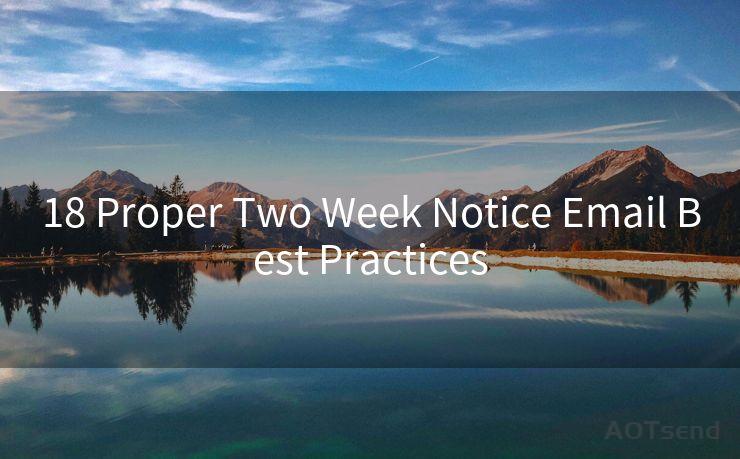18 Proper Two Week Notice Email Best Practices




When it comes to professional etiquette, giving a proper two-week notice before leaving a job is considered standard practice. This notice allows your employer to prepare for your departure and ensures a smooth transition for both parties. In this article, we'll explore 18 best practices for writing an effective two-week notice email, helping you maintain professionalism and leave a positive impression.
1. Clear and Concise Subject Line
Start with a subject line that clearly states your intention. For example, "Two-Week Notice of Resignation - [Your Name]". This sets the tone for the email and prepares the reader for the content that follows.
2. Formal Greeting
Begin your email with a formal greeting, addressing your manager or HR representative by their proper title and name. This demonstrates respect and professionalism.
3. Express Gratitude
Thank your employer for the opportunities and experiences you've had during your tenure. This positive tone sets the stage for a respectful farewell.
4. State Your Intention
Clearly and directly state your intention to resign and your last day of work. Avoid ambiguity or vagueness.
5. Provide a Reason (Optional)
While it's not mandatory to provide a reason for your resignation, offering a brief explanation can help maintain a positive relationship with your employer. Keep it professional and avoid negative or emotional language.
6. Offer to Assist in the Transition
Express your willingness to help with the transition process, whether it's training your replacement, documenting procedures, or assisting with any outstanding projects.
7. Request Feedback
Invite feedback from your manager or team members on how you can best support the transition. This shows that you value their input and are committed to a smooth transition.
8. Maintain Confidentiality
If you're moving to a competitor or have sensitive information about your next role, avoid disclosing too much detail in your resignation email.
9. Proofread and Edit
Ensure your email is polished and professional by proofreading and editing before sending. Typos or grammatical errors can detract from your message.
10. Send It Timely
Give your employer enough time to adjust by sending your notice early enough, ideally two weeks before your intended last day.
11. Forward-Thinking Tone
Adopt a forward-thinking tone that focuses on the future and maintains a positive attitude.
12. Avoid Burning Bridges
Refrain from making negative comments or criticisms in your notice. You never know when you might need to collaborate with these individuals again.

13. Include Contact Information
Provide your contact information in case there are any questions or further discussions needed after your departure.
14. CC Relevant Parties
If necessary, consider carbon copying (CC) relevant parties, such as HR or your direct manager, to ensure everyone is informed.
15. Keep It Short and Sweet
While it's important to cover all necessary points, keep your email concise. Avoid lengthy explanations or unnecessary details.
16. Follow Company Protocol
Be aware of and follow any specific resignation procedures or protocols your company may have.
17. Send a Follow-Up Email (If Needed)
If there are any unresolved issues or further assistance required, don't hesitate to send a follow-up email.
18. Close With Gratitude
End your email by thanking your employer again and expressing your appreciation for the opportunities you've had. This leaves a lasting positive impression.
By following these best practices, you can craft a professional and respectful two-week notice email that maintains your professional reputation and fosters positive relationships with your former colleagues.
🔔🔔🔔
【AOTsend Email API】:AOTsend is a Managed Email Service for sending transactional emails. Support Email Types: reminders, authentication, confirmations, notifications, verification codes, invoices, password resets, account activations, billing statements, two-factor authentication (2FA), and one-time passwords (OTP) emails, etc. $0.28 per 1000 Emails. 99% Delivery, 98% Inbox Rate.
You might be interested in:
Why did we start the AOTsend project, Brand Story?
What is a Managed Email API, How it Works?
Best 25+ Email Marketing Platforms (Authority,Keywords&Traffic Comparison)
Best 24+ Email Marketing Service (Price, Pros&Cons Comparison)
Email APIs vs SMTP: How they Works, Any Difference?




Scan the QR code to access on your mobile device.
Copyright notice: This article is published by AotSend. Reproduction requires attribution.
Article Link:https://www.mailwot.com/p2782.html



